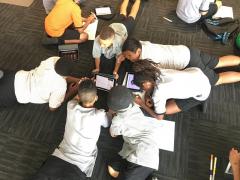Ormiston Junior College (OJC), situated at Flat Bush in East Auckland and established in February 2017, is a middle school for students from years 7 to 10. Although the student population is small at the moment, the school will eventually accommodate 1000 students.
The college is in a new building, constructed as an ILE (Innovative Learning Environment). The new design of the teaching spaces has allowed the school to develop an innovative approach to teaching and learning.
Approach to teaching and learning
Our OJC curriculum has four key components in how we use our time and space as a resource in the ILE.
MAC/Kainga: (Mentor Advisor Coach, Kainga – a gathering)
The purpose of this element is to provide personalised support and learning programmes for the holistic development of our learners. There is a particular focus on Social/Emotional Learning, Learning to Learn and Metacognitive skills, knowledge and dispositions for better learning, and Hauora. The key competencies are most closely related to this curriculum as are elements of the Health and Social Sciences learning areas.
Whānau Ora: (The health of our family)
The purpose of this element is to explicitly provide daily opportunities for movement and taha tinana in order to support hauora, but also to support our learners' ability to learn and concentrate throughout the day. Again, the key competencies and the personal hauroa components of the Health and PE curriculum are covered through this programme.
Literacy and numeracy learning labs
Our community has one of the highest numbers of immigrant and English language learners in New Zealand. As a middle school, these core skills and how they relate to the rest of the curriculum are vitally important, to ensure we are preparing students for success in accessing and processing information at the senior secondary level. This programme teaches literacy and numeracy with a metacognitive and transdisciplinary focus, and also involves the learners handing in and getting support with work from all other areas of the OJC curriculum.
TAIP (Transdisciplinary Authentic Inquiry Projects)
Our project-based learning curriculum takes up half our timetable. Students complete at least three projects each year that are connected to school-wide big ideas and enduring understandings. Each project must meet the TAIP design principles. All curriculum areas and disciplines are fair game for exploration for the student projects as long as the principles are met.
Learning coach design principles – Learner design principles
In order to assess for learning and report and tell the story of each child’s learning and progress, a system was needed which allowed each learner to effectively have the entire “scheme” available to them. It was also important that the system/methods we chose allowed students to meet the criteria consistently, but allowed for freedom and flexibility in how the criteria were met for each learner. It was at this point we chose to pursue the concepts of narrative assessment combined with digital badging and micro-credentials to support our vision for high-quality assessment for (and ‘as’) learning and reporting to parents. The concept is based on the LRNG process used in the USA and extended and developed for use in the school.


